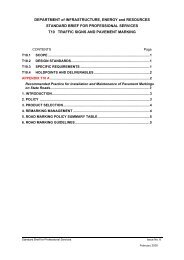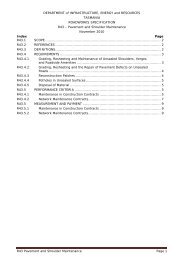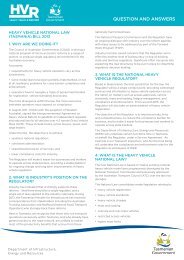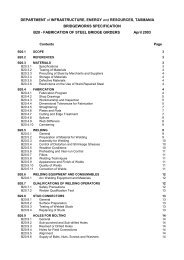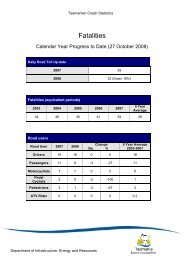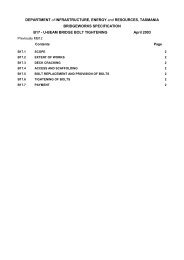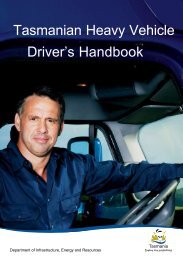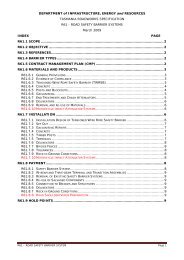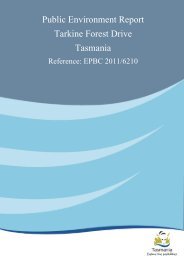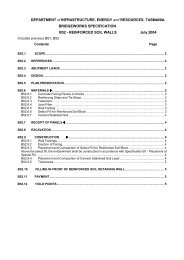Unlicensed drivers and unregistered vehicles in Tasmania - Transport
Unlicensed drivers and unregistered vehicles in Tasmania - Transport
Unlicensed drivers and unregistered vehicles in Tasmania - Transport
You also want an ePaper? Increase the reach of your titles
YUMPU automatically turns print PDFs into web optimized ePapers that Google loves.
UNLICENSED DRIVERS AND UNREGISTERED VEHICLES IN<br />
TASMANIA:<br />
Department of Infrastructure, Energy <strong>and</strong> Resources<br />
1
UNLICENSED DRIVERS AND UNREGISTERED VEHICLES IN TASMANIA:<br />
A ROAD SAFETY PERSPECTIVE<br />
CONTENTS<br />
BACKGROUND ......................................................................................................................................... 3<br />
UNLICENSED DRIVING ............................................................................................................................ 3<br />
WHAT IS UNLICENSED DRIVING ............................................................................................................ 3<br />
REASONS WHY PEOPLE LOSE THEIR LICENCE ......................................................................................... 4<br />
PREVALENCE OF UNLICENSED DRIVERS .................................................................................................. 5<br />
WHY PEOPLE DRIVE UNLICENSED ......................................................................................................... 7<br />
STRATEGIES TO DETECT AND DETER UNLICENSED DRIVING .................................................................. 8<br />
UNLICENSED DRIVERS IN CRASHES ....................................................................................................... 13<br />
UNREGISTERED VEHICLES ..................................................................................................................... 17<br />
WHAT IS AN UNREGISTERED VEHICLE ................................................................................................ 17<br />
REASONS WHY VEHICLES ARE UNREGISTERED ..................................................................................... 17<br />
DETECTING AND REDUCING UNREGISTERED VEHICLES ....................................................................... 19<br />
UNREGISTERED VEHICLES IN CRASHES ................................................................................................. 20<br />
CONCLUSION ......................................................................................................................................... 21<br />
2
UNLICENSED DRIVERS AND UNREGISTERED VEHICLES IN TASMANIA:<br />
A ROAD SAFETY PERSPECTIVE<br />
BACKGROUND<br />
<strong>Unlicensed</strong> driv<strong>in</strong>g is not unique to <strong>Tasmania</strong>, the issue of driv<strong>in</strong>g whilst never hav<strong>in</strong>g held a licence<br />
<strong>and</strong> driv<strong>in</strong>g whilst suspended or disqualified is a national issue <strong>and</strong> is currently be<strong>in</strong>g addressed by<br />
the National Licens<strong>in</strong>g Work<strong>in</strong>g Group <strong>and</strong> Registration <strong>and</strong> Licens<strong>in</strong>g Taskforce.<br />
The National Licens<strong>in</strong>g Work<strong>in</strong>g Group has recently commissioned the Centre for Automotive Safety<br />
Research (CASR) from the University of Adelaide to <strong>in</strong>vestigate measures to reduce the <strong>in</strong>cidence of<br />
unlicensed driv<strong>in</strong>g.<br />
This Report provides an analysis of <strong>Tasmania</strong>n licens<strong>in</strong>g, registration <strong>and</strong> crash statistics as well as<br />
current <strong>in</strong>formation on the reasons for these behaviours <strong>and</strong> mitigation measures.<br />
UNLICENSED DRIVING<br />
WHAT IS UNLICENSED DRIVING<br />
The <strong>Tasmania</strong>n Vehicle <strong>and</strong> Traffic Act 1999 requires the driver or rider of a motor vehicle on a public<br />
street to hold a valid driver’s licence for the type of vehicle they are operat<strong>in</strong>g. There are 365,019<br />
licensed <strong>drivers</strong> <strong>in</strong> <strong>Tasmania</strong>, the majority be<strong>in</strong>g full licence holders which total 328,458. See figure 1<br />
below.<br />
CURRENT LICENCES<br />
AS AT 31ST DECEMBER 2011<br />
350,000<br />
300,000<br />
250,000<br />
200,000<br />
150,000<br />
100,000<br />
50,000<br />
0<br />
FULL PROVISIONAL LEARNER<br />
Figure 1 – The number of licensed <strong>drivers</strong> – <strong>Tasmania</strong>, 2011.<br />
The Vehicle <strong>and</strong> Traffic Act 1999 acknowledges not all <strong>drivers</strong> will abide by this condition <strong>and</strong><br />
provides provisions for offences relat<strong>in</strong>g to driv<strong>in</strong>g under the follow<strong>in</strong>g conditions:<br />
• never hav<strong>in</strong>g obta<strong>in</strong>ed a licence<br />
• licensed <strong>in</strong> another country only but not exempted from the requirement to hold a licence <strong>in</strong><br />
the Australian jurisdiction <strong>in</strong> which they are driv<strong>in</strong>g<br />
• driv<strong>in</strong>g with a suspended or cancelled licence<br />
3
• driv<strong>in</strong>g while disqualified<br />
• driv<strong>in</strong>g with an expired licence<br />
• driv<strong>in</strong>g with an adm<strong>in</strong>istrative suspension (eg. medical grounds)<br />
• driv<strong>in</strong>g with a suspended licence due to the Monetary Penalties Act 2005.<br />
Contemporary literature reviews <strong>and</strong> research studies have found comb<strong>in</strong><strong>in</strong>g the different forms of<br />
unlicensed driv<strong>in</strong>g beneficial when attempt<strong>in</strong>g to analyse the associated issues.<br />
Further, crash reports received by road authorities are often unable to dist<strong>in</strong>guish between licence<br />
categories <strong>and</strong> status, i.e. data is limited to no licence, full licence <strong>and</strong> provisional or learner driver.<br />
REASONS WHY PEOPLE LOSE THEIR LICENCE<br />
When exam<strong>in</strong><strong>in</strong>g the issue of unlicensed driv<strong>in</strong>g, it is important to consider the “primary cause” or<br />
ma<strong>in</strong> reasons for the unlicensed status. These are:<br />
• M<strong>and</strong>atory disqualification for dr<strong>in</strong>k driv<strong>in</strong>g<br />
• M<strong>and</strong>atory disqualification for excessive speed<br />
• M<strong>and</strong>atory disqualification for driv<strong>in</strong>g without ever hold<strong>in</strong>g a licence<br />
• Suspension through accrual of demerit po<strong>in</strong>ts<br />
• Adm<strong>in</strong>istrative suspension due to medical condition or non-renewal of licence<br />
• Suspension due to unpaid f<strong>in</strong>es by order of the Monetary Penalties Act 2005.<br />
M<strong>and</strong>atory disqualification for dr<strong>in</strong>k driv<strong>in</strong>g<br />
The most common sanction for dr<strong>in</strong>k driv<strong>in</strong>g has been f<strong>in</strong>es <strong>and</strong> licence disqualification. The period<br />
of disqualification is determ<strong>in</strong>ed by the magistrate tak<strong>in</strong>g <strong>in</strong>to account all relevant factors.<br />
M<strong>and</strong>atory disqualification for excessive speed<br />
M<strong>and</strong>atory disqualification for excessive speed was <strong>in</strong>troduced <strong>in</strong> 2001 <strong>in</strong> an effort to provide an<br />
appropriate sanction for the approximately 500 <strong>drivers</strong> apprehended each year travell<strong>in</strong>g at<br />
excessive speeds (exceed<strong>in</strong>g the speed limit by 38 km/h results <strong>in</strong> a 3 month disqualification period<br />
<strong>and</strong> exceed<strong>in</strong>g the speed limit by 45 km/h results <strong>in</strong> a 4 month disqualification period).<br />
M<strong>and</strong>atory disqualification for driv<strong>in</strong>g without ever hold<strong>in</strong>g a licence<br />
Those caught driv<strong>in</strong>g that have never held a licence are often sentenced to a period of<br />
disqualification before they can enter the licens<strong>in</strong>g system.<br />
Suspension through accrual of demerit po<strong>in</strong>ts<br />
The accrual of demerit po<strong>in</strong>ts for m<strong>in</strong>or offences, over a short period of time results <strong>in</strong> licence<br />
suspension. After three years from the date of the offence, the demerit po<strong>in</strong>ts are no longer taken<br />
<strong>in</strong>to consideration. Demerit po<strong>in</strong>ts for speed<strong>in</strong>g offences were <strong>in</strong>creased <strong>in</strong> 2009.<br />
Adm<strong>in</strong>istrative suspension due to medical condition or non-renewal of licence<br />
Licences can be suspended by the Registrar due to medical conditions that could make driv<strong>in</strong>g<br />
unsafe. The Registrar also has the power to refuse renewal of a licence <strong>in</strong> certa<strong>in</strong> circumstances.<br />
4
Adm<strong>in</strong>istrative suspensions have the highest level of compliance <strong>in</strong> relation to exemption from<br />
driv<strong>in</strong>g.<br />
Suspension due to unpaid f<strong>in</strong>es by order of the Monetary Penalties Act 2005<br />
Enforcement orders can be issued for any <strong>in</strong>fr<strong>in</strong>gement notice or court f<strong>in</strong>e that is not paid by the<br />
due date. Non-payment of an enforcement order results <strong>in</strong> an enforcement sanction whereby a<br />
driver’s licence or registration can be suspended.<br />
PREVALENCE OF UNLICENSED DRIVERS<br />
Quantitative data obta<strong>in</strong>ed from the <strong>Tasmania</strong>n Motor Registry System (MRS) shows an <strong>in</strong>crease <strong>in</strong><br />
the total number of unlicensed <strong>drivers</strong> be<strong>in</strong>g detected.<br />
4,000<br />
3,000<br />
2,000<br />
1,000<br />
NUMBER OF CONVICTIONS 2002 - 2011<br />
DRIVE WHILST DISQUALIFIED, DRIVE WHILST SUSPENDED, UNLICENSED DRIVING<br />
0<br />
2002 2003 2004 2005 2006 2007 2008 2009 2010 2011<br />
Figure 2 – The number of unlicensed driv<strong>in</strong>g convictions per year from 2002 to 2011 (Motor Registry<br />
System, DIER).<br />
The <strong>in</strong>crease is most likely attributed to the <strong>in</strong>troduction of sanctions <strong>in</strong>volv<strong>in</strong>g greater demerit<br />
po<strong>in</strong>ts or automatic disqualification of licence for high risk or dangerous driv<strong>in</strong>g offences as well as<br />
enhanced detection.<br />
The data has been further separated <strong>in</strong>to the categories of driv<strong>in</strong>g while disqualified <strong>and</strong> driv<strong>in</strong>g<br />
while suspended. The number of <strong>drivers</strong> detected driv<strong>in</strong>g whilst disqualified has <strong>in</strong>creased (Figure 3)<br />
as has the number detected driv<strong>in</strong>g while suspended (Figure 4).<br />
5
NUMBER OF DRIVE WHILST DISQUALIFIED<br />
CONVICTIONS BY YEAR<br />
1,500<br />
1,000<br />
500<br />
0<br />
2002 2003 2004 2005 2006 2007 2008 2009 2010 2011<br />
Figure 3: Driv<strong>in</strong>g while disqualified – <strong>Tasmania</strong>.<br />
The <strong>in</strong>troduction of the Monetary Penalties Act 2005 has resulted <strong>in</strong> an <strong>in</strong>crease <strong>in</strong> licence<br />
suspensions. There has been an <strong>in</strong>crease <strong>in</strong> the number detected driv<strong>in</strong>g while suspended s<strong>in</strong>ce<br />
Monetary Penalty Enforcement System came <strong>in</strong>to effect.<br />
800<br />
NUMBER OF DRIVE WHILST SUSPENDED<br />
CONVICTIONS BY YEAR<br />
600<br />
400<br />
200<br />
0<br />
2002 2003 2004 2005 2006 2007 2008 2009 2010 2011<br />
Figure 4: Driv<strong>in</strong>g whilst suspended – <strong>Tasmania</strong>.<br />
The reason for licence suspension <strong>in</strong> <strong>Tasmania</strong> <strong>in</strong> 2011 is shown <strong>in</strong> Figure 5. This <strong>in</strong>dicates that the<br />
majority of licence suspensions (66 per cent) were monetary penalty enforcement suspensions, 23<br />
per cent were adm<strong>in</strong>istrative sanctions imposed by the Registrar <strong>and</strong> 11 per cent were due to<br />
demerit po<strong>in</strong>t accumulation.<br />
6
PERCENTAGE OF ALL LICENCE HOLDER SUSPENSIONS BY REASON<br />
2011<br />
MPEP Licence<br />
Suspension,<br />
4826<br />
Adm<strong>in</strong>istrative<br />
Suspension,<br />
1648 Full Licence<br />
Suspension,<br />
474<br />
Learner<br />
Suspension, 20<br />
Provisional<br />
Suspension,<br />
305<br />
Figure 5: The Percentage of licence suspensions by reason , <strong>Tasmania</strong>, 2011<br />
Despite <strong>in</strong>creases <strong>in</strong> the number of <strong>drivers</strong> detected driv<strong>in</strong>g unlicensed the proportion of unlicensed<br />
<strong>drivers</strong> rema<strong>in</strong>s comparatively low <strong>in</strong> relation to the overall number of licensed <strong>drivers</strong> (See Figure<br />
6).<br />
PERCENTAGE OF UNLICENCED<br />
DRIVERS BY LICENCE CATEGORY<br />
All<br />
LEARNER<br />
PROVISIONAL<br />
FULL<br />
0% 20% 40% 60% 80% 100%<br />
Figure 6: Percentage of unlicensed <strong>drivers</strong> by licence category<br />
Analysis of licence statistics revealed it is a small number of unlicensed <strong>drivers</strong> who cont<strong>in</strong>ue to<br />
repeat the primary cause of loss of licence or engage <strong>in</strong> other high risk behaviours whilst driv<strong>in</strong>g<br />
unlicensed that are of most concern.<br />
WHY PEOPLE DRIVE UNLICENSED<br />
While <strong>Tasmania</strong>n data is not available, the Centre for Automotive Safety Research (CASR) from the<br />
University of Adelaide is currently <strong>in</strong>vestigat<strong>in</strong>g this issue. CASR’s prelim<strong>in</strong>ary report revealed, from a<br />
7
series of focus groups with disqualified <strong>drivers</strong>, 60 per cent admitted to driv<strong>in</strong>g despite their<br />
disqualification.<br />
Reasons given as justification for cont<strong>in</strong>u<strong>in</strong>g to drive whist disqualified <strong>in</strong>cluded: not consider<strong>in</strong>g the<br />
primary offence as dangerous; view<strong>in</strong>g the disqualification as unfair; <strong>and</strong> rationalis<strong>in</strong>g fears of<br />
further penalties by the belief that the maximum penalties are rarely applied <strong>in</strong> the legal system.<br />
The CASR survey reported:<br />
…associated with disqualified driv<strong>in</strong>g was a low perceived risk of detection <strong>and</strong> <strong>in</strong>stances of<br />
personal <strong>and</strong> vicarious experiences with punishment avoidance (i.e. driv<strong>in</strong>g while disqualified<br />
<strong>and</strong> not be<strong>in</strong>g detected).<br />
REASON FOR TRAVEL<br />
AT TIME OF DETECTION<br />
Work<br />
related<br />
26% Social<br />
Recreational<br />
54%<br />
Family related<br />
16%<br />
Other 4%<br />
Figure 7: Reasons cited by offenders for driv<strong>in</strong>g unlicensed driv<strong>in</strong>g dur<strong>in</strong>g a confidential study -<br />
Queensl<strong>and</strong>.<br />
A series of <strong>in</strong>terviews with unlicensed <strong>drivers</strong> <strong>in</strong> Brisbane revealed that most illegal driv<strong>in</strong>g <strong>in</strong>volved<br />
trips to see friends or take part <strong>in</strong> social activities, as opposed to work or family commitments<br />
(Figure 7).<br />
A number of unlicenced <strong>drivers</strong> do not renter the licens<strong>in</strong>g system when prohibition ceases, reasons<br />
<strong>in</strong>clude a medical condition prevent<strong>in</strong>g return, serv<strong>in</strong>g a period of imprisonment or<br />
<strong>in</strong>stitutionalization, mov<strong>in</strong>g <strong>in</strong>terstate or overseas or voluntarily choos<strong>in</strong>g to no longer drive.<br />
Appendix C <strong>and</strong> D present data for unlicenced <strong>drivers</strong> return<strong>in</strong>g to the system.<br />
STRATEGIES TO DETECT AND DETER UNLICENSED DRIVING<br />
Increases <strong>in</strong> the apprehension of unlicensed <strong>drivers</strong> can be attributed to improved detection<br />
methods, <strong>in</strong>itiatives such as compulsory carriage of licence, automatic number plate recognition,<br />
prevalence of speed detection devices <strong>and</strong> the extent of r<strong>and</strong>om breath test<strong>in</strong>g <strong>and</strong> targeted general<br />
enforcement of high risk offenders.<br />
A national assessment of how unlicensed <strong>drivers</strong> are detected is represented <strong>in</strong> Figure 8. It shows<br />
that, while a variety of detection measures are used, most are detected through committ<strong>in</strong>g further<br />
8
traffic offences <strong>and</strong> roadside enforcement, while only 3.9% came to be detected through<br />
<strong>in</strong>volvement <strong>in</strong> a crash.<br />
Licence check,<br />
9.4%<br />
Other<br />
12.6%<br />
Involved <strong>in</strong><br />
crash, 3.9%<br />
METHOD OF DETECTION<br />
OF UNLICENSED DRIVERS<br />
2011- National<br />
Unsure, 18.4%<br />
Traffic offence,<br />
33.7%<br />
RBT, 22%<br />
Figure 8: <strong>Unlicensed</strong> <strong>drivers</strong> are detected through a variety of enforcement activities, however the<br />
most common cause for detection was through further traffic offences.<br />
It is clear that one s<strong>in</strong>gle approach to unlicensed driv<strong>in</strong>g will not be effective as there are a range of<br />
reasons for driv<strong>in</strong>g unlicensed as well as a number of ways this behavior is detected. A broader<br />
approach us<strong>in</strong>g a range of measures will have greater effect. A number of measures for deterr<strong>in</strong>g<br />
unlicensed driv<strong>in</strong>g are discussed below.<br />
Automatic Number Plate Recognition<br />
The use of Automatic Number Plate Recognition (ANPR) software systems has been <strong>in</strong>strumental <strong>in</strong><br />
both detect<strong>in</strong>g <strong>and</strong> deterr<strong>in</strong>g a range of illegal road user behaviors <strong>in</strong>clud<strong>in</strong>g unlicensed driv<strong>in</strong>g, the<br />
driv<strong>in</strong>g of <strong>unregistered</strong> <strong>vehicles</strong>, <strong>and</strong> the non-compliance of heavy vehicle <strong>drivers</strong> with driv<strong>in</strong>g hour<br />
regulations <strong>and</strong> novice <strong>drivers</strong> with provisional licence requirements.<br />
The ANPR software system is l<strong>in</strong>ked to a camera that takes an image of a licence plate converts it to<br />
digital data <strong>and</strong> compares the data with registration details from the licens<strong>in</strong>g database to identify<br />
<strong>unregistered</strong> <strong>vehicles</strong> <strong>and</strong> <strong>vehicles</strong> registered to unlicensed <strong>drivers</strong> <strong>and</strong> motorcyclists.<br />
Vehicles belong<strong>in</strong>g to unlicensed <strong>drivers</strong> can be pulled over by police to ascerta<strong>in</strong> whether an<br />
unlicensed driver is <strong>in</strong> control of the vehicle at that time.<br />
In <strong>Tasmania</strong>, ANPR has been used s<strong>in</strong>ce 2009 to target unlicensed driv<strong>in</strong>g <strong>and</strong> <strong>unregistered</strong> <strong>vehicles</strong>.<br />
M<strong>and</strong>atory carriage of a driver licence<br />
<strong>Tasmania</strong> <strong>in</strong>troduced compulsory carriage of licence <strong>in</strong> December 2002, its primary purpose was to<br />
act as a deterrent to unlicensed <strong>drivers</strong> cont<strong>in</strong>u<strong>in</strong>g to drive dur<strong>in</strong>g their prohibition.<br />
The advantage of strict m<strong>and</strong>atory carriage of licence laws is that once a driver has been pulled over<br />
by police, they must produce a photographic licence that can then be verified by the police officer to<br />
ensure that the driver is licensed to be driv<strong>in</strong>g the vehicle. Failure to produce a driver’s licence on<br />
request can result <strong>in</strong> a $70 penalty.<br />
9
Encouragement to enter the Licens<strong>in</strong>g system<br />
The most common reason given by persons apprehended for driv<strong>in</strong>g whilst never hav<strong>in</strong>g held a<br />
licence is the difficulty or perceived difficulty of enter<strong>in</strong>g the official system. This is particularly<br />
common for those liv<strong>in</strong>g <strong>in</strong> remote communities, with low levels of literacy, with difficulty <strong>in</strong><br />
underst<strong>and</strong><strong>in</strong>g the English language <strong>and</strong> with difficulty <strong>in</strong> establish<strong>in</strong>g identity through official<br />
documentation.<br />
For these groups when entrance <strong>in</strong>to the licens<strong>in</strong>g system is successful, access to roadworthy,<br />
registered <strong>vehicles</strong>, <strong>and</strong> to appropriate supervis<strong>in</strong>g <strong>drivers</strong> will<strong>in</strong>g <strong>and</strong> able to fulfill the m<strong>in</strong>imum<br />
hours of supervised driv<strong>in</strong>g requirements can be difficult to access. Consequently such people may<br />
choose to drive unlicensed or unsupervised.<br />
In order to address these issues <strong>in</strong> <strong>Tasmania</strong>, DIER has enabled community based assistance<br />
programs target<strong>in</strong>g the socially disadvantaged. Assistance with the driver knowledge test<strong>in</strong>g system<br />
or ‘learner test’ is provided through local LINCS, job networks, neighborhood houses, correctional<br />
<strong>in</strong>stitutions <strong>and</strong> organisations target<strong>in</strong>g cultural <strong>and</strong> spatial disadvantage.<br />
In addition, DIER has assisted <strong>in</strong> provid<strong>in</strong>g fund<strong>in</strong>g <strong>and</strong> support for Learner Driver Mentor Programs<br />
(LDMP). A LDMP arranges a suitable vehicle <strong>and</strong> supervisor driver for a disadvantaged community<br />
member, giv<strong>in</strong>g them the opportunity to achieve the m<strong>in</strong>imum 50 hours of supervised driv<strong>in</strong>g before<br />
becom<strong>in</strong>g eligible to sit for a provisional licence.<br />
F<strong>in</strong>es<br />
The most common form of sanction rout<strong>in</strong>ely adm<strong>in</strong>istered to offenders is a monetary f<strong>in</strong>e.<br />
Appendix A displays the monetary sanctions for driv<strong>in</strong>g without a licence, driv<strong>in</strong>g whilst suspended<br />
<strong>and</strong> driv<strong>in</strong>g whilst disqualified <strong>in</strong> each jurisdiction.<br />
The ability to pay a f<strong>in</strong>e is often discussed when monetary f<strong>in</strong>es are considered. To address this<br />
concern, the Monetary Penalties Enforcement System (MPES) allows for payment plans to be<br />
entered <strong>in</strong>to.<br />
Period of Good Behavior<br />
In <strong>Tasmania</strong>, <strong>in</strong>stead of a driver hav<strong>in</strong>g their licence suspended, they may <strong>in</strong> specific circumstances<br />
apply for a period of good behavior. This is an option to avoid suspension provid<strong>in</strong>g the proposed<br />
suspension is due to accumulation of demerit po<strong>in</strong>ts <strong>and</strong> they are not a learner or provisional licence<br />
holder.<br />
Restricted Licence<br />
A concern often raised about licence suspension or disqualification is that it can be overly punitive,<br />
particularly if it prevents offenders from earn<strong>in</strong>g a liv<strong>in</strong>g.<br />
Many jurisdictions, <strong>in</strong>clud<strong>in</strong>g <strong>Tasmania</strong>, utilise restricted licences for offenders who can demonstrate<br />
that they (<strong>and</strong>/or their family) would suffer disadvantage from the loss of their licence. Restricted<br />
10
licences typically permit offenders to drive for specific purposes, such as travell<strong>in</strong>g to <strong>and</strong> from<br />
employment.<br />
Rehabilitation <strong>and</strong> education programs<br />
Evidence suggests that rehabilitation <strong>and</strong> education programs have their place <strong>in</strong> the correctional<br />
system. For example, these types of programs have been established to target dr<strong>in</strong>k <strong>drivers</strong>. The<br />
primary aim of dr<strong>in</strong>k driv<strong>in</strong>g programs is to separate dr<strong>in</strong>k<strong>in</strong>g from driv<strong>in</strong>g by provid<strong>in</strong>g participants<br />
with the knowledge, skills <strong>and</strong> strategies to avoid further offend<strong>in</strong>g behavior.<br />
One such example is the Sober Driver Program (SDP) developed by the Department of Corrective<br />
Services, NSW, <strong>in</strong> collaboration with the Motor Accidents Authority <strong>and</strong> the Roads <strong>and</strong> Traffic<br />
Authority. The most conservative <strong>in</strong>dependent study <strong>in</strong> relation to the outcomes of the NSW SDP<br />
found that 43 per cent of participants were less likely to re-offend over a 2 year period.<br />
The SDP was <strong>in</strong>troduced <strong>in</strong>to <strong>Tasmania</strong>n Community Corrections <strong>in</strong> July 2008. It has been designed<br />
specifically for repeat dr<strong>in</strong>k driv<strong>in</strong>g offenders who are over the age of 18, have been convicted of<br />
two or more dr<strong>in</strong>k driv<strong>in</strong>g convictions with<strong>in</strong> a 5-year period, are subject to a community based<br />
order (e.g. a Probation <strong>and</strong>/or Community Service Order) <strong>and</strong> are directed to attend the program.<br />
Target<strong>in</strong>g <strong>and</strong> chang<strong>in</strong>g the high risk behaviours that often lead to unlicensed driv<strong>in</strong>g should also<br />
flow on to deter driv<strong>in</strong>g unlicensed itself <strong>and</strong> future loss of licence.<br />
Alcohol Interlocks<br />
An alcohol ignition <strong>in</strong>terlock is a device that measures an <strong>in</strong>dividual’s blood alcohol content (BAC). It<br />
is connected to the ignition <strong>and</strong> power system of a vehicle <strong>and</strong> is designed to prevent the vehicle<br />
from be<strong>in</strong>g started if the driver’s BAC exceeds the legal limit.<br />
Alcohol Interlock trials <strong>in</strong> Ohio reported that when an <strong>in</strong>terlock was <strong>in</strong>stalled, recidivism rates were<br />
lower by 65 per cent, while unlicensed driv<strong>in</strong>g was reduced by 91 per cent. Similar patterns are<br />
emerg<strong>in</strong>g <strong>in</strong> early evaluations across Australia.<br />
Alcohol Interlocks are be<strong>in</strong>g <strong>in</strong>troduced <strong>in</strong> <strong>Tasmania</strong> <strong>in</strong> early 2013.<br />
Vehicle immobilisation <strong>and</strong> impoundment<br />
In <strong>in</strong>stances where licens<strong>in</strong>g sanctions have proved to be <strong>in</strong>effective <strong>and</strong> <strong>drivers</strong> cont<strong>in</strong>ue to drive<br />
unlicensed, vehicle sanctions have proven to be successful.<br />
All Australian jurisdictions have <strong>in</strong>troduced vehicle immobilisation <strong>and</strong> impoundment schemes. The<br />
primary purpose of these is to curb hoon<strong>in</strong>g activity, but the <strong>in</strong>itiative has also been successful <strong>in</strong><br />
limit<strong>in</strong>g unlicensed driv<strong>in</strong>g behavior.<br />
National research has found that, for unlicensed <strong>drivers</strong> to which vehicle sanctions were applied, the<br />
majority (62.5 per cent) were driv<strong>in</strong>g their own vehicle. A further 11.4 per cent were driv<strong>in</strong>g a vehicle<br />
owned by a family member. (See Figure 7).<br />
11
Other, 4.6%<br />
OWNER OF VEHICLE<br />
AT TIME OF DETECTION<br />
Friend, 21.4%<br />
Family<br />
Member,<br />
11.4%<br />
Registered<br />
Owner, 62.5%<br />
Figure 9: Vehicle sanctions prove effective, 62.5% of unlicensed <strong>drivers</strong> were driv<strong>in</strong>g their own vehicle<br />
(National research).<br />
Currently vehicle immobilisation or impoundment is applied <strong>in</strong> <strong>Tasmania</strong> to those driv<strong>in</strong>g whilst<br />
disqualified for a second or subsequent offence. A second offence of driv<strong>in</strong>g whilst disqualified can<br />
result <strong>in</strong> a 28 day immobilisation or impoundment. For a third offence, the period is three months,<br />
<strong>and</strong> for a fourth offence, the vehicle is held until a court appearance, with vehicle forfeiture the<br />
likely result.<br />
In <strong>Tasmania</strong>, over a period of 17 months, there were 622 <strong>vehicles</strong> impounded <strong>and</strong> 1189 <strong>vehicles</strong><br />
immobilized. Light <strong>vehicles</strong> accounted for 89 per cent of these <strong>and</strong> 10 per cent were motorcycles.<br />
The offence of driv<strong>in</strong>g while disqualified accounted for 130 impoundments (21%) <strong>and</strong> 334<br />
immobilisations (28%). Figure 10 below shows the total number of vehicle sanctions <strong>in</strong> <strong>Tasmania</strong><br />
s<strong>in</strong>ce 2007.<br />
1000<br />
800<br />
600<br />
400<br />
200<br />
0<br />
VEHICLES CLAMPED OR CONFISCATED BY TASMANIA POLICE<br />
2007 - 2011<br />
2007 2008 2009 2010 2011<br />
Figure 10: The number of <strong>vehicles</strong> clamped or impounded by police is grow<strong>in</strong>g each year.<br />
Imprisonment<br />
Imprisonment is used as a punishment for the more serious unlicensed driv<strong>in</strong>g offenders. For the<br />
offence of driv<strong>in</strong>g without a licence, only Victoria, Northern Territory <strong>and</strong> Queensl<strong>and</strong> provide for a<br />
possible prison term for all offenders. In the Australian Capital Territory, New South Wales, South<br />
12
Australia <strong>and</strong> <strong>Tasmania</strong>, it is only repeat offenders who risk imprisonment, while <strong>in</strong> New Zeal<strong>and</strong> <strong>and</strong><br />
Western Australia, imprisonment for not be<strong>in</strong>g licensed is not available as a penalty.<br />
Better communication with <strong>drivers</strong><br />
A common claim by those detected driv<strong>in</strong>g unlicensed is that they are unaware that their licence has<br />
been cancelled or suspended. This primarily relates to licence suspensions occurr<strong>in</strong>g due to unpaid<br />
f<strong>in</strong>es under the Monetary Penalties Act.<br />
A survey of 309 unlicensed driv<strong>in</strong>g offenders <strong>in</strong> Queensl<strong>and</strong> found that 36 per cent of them were<br />
unaware that they were unlicensed. Among <strong>drivers</strong> with cancelled licences, nearly 60 per cent<br />
claimed that they had not received notification <strong>in</strong> the mail, although some acknowledged that they<br />
had changed address.<br />
When a driver claims no knowledge of a licence suspension, Magistrates have generally accepted<br />
this excuse, as it is plausible that suspension orders sent <strong>in</strong> the mail may not reach the <strong>drivers</strong><br />
<strong>in</strong>volved.<br />
This has lead to some jurisdictions, such as South Australia, <strong>in</strong>vok<strong>in</strong>g ‘Proof of Service’ legislation.<br />
Proof of Service legislation requires that <strong>drivers</strong> sent suspension orders attend a licens<strong>in</strong>g office <strong>in</strong><br />
person <strong>and</strong> acknowledge that they have received the letter advis<strong>in</strong>g of the suspension. If a driver is<br />
not seen with<strong>in</strong> a specified period of time, the Sheriff is dispatched to f<strong>in</strong>d the driver <strong>and</strong> <strong>in</strong>form him<br />
or her of the suspension. This has led to a marked <strong>in</strong>crease <strong>in</strong> the proportion of <strong>drivers</strong> with<br />
suspended licences who come <strong>in</strong> to acknowledge a suspension (now 97%) <strong>and</strong> who can no longer<br />
claim ignorance if detected driv<strong>in</strong>g unlicensed.<br />
Technology<br />
Technological advancements provide opportunities to further reduce the <strong>in</strong>cidence of unlicensed<br />
driv<strong>in</strong>g, however most <strong>in</strong>itiatives are still cost prohibitive.<br />
The use of electronic driver licences that double as an ignition key, has been suggested as an<br />
effective tool for reduc<strong>in</strong>g the <strong>in</strong>cidence of unlicensed driv<strong>in</strong>g. Trial outcomes will be monitored.<br />
UNLICENSED DRIVERS IN CRASHES<br />
The Australian <strong>Transport</strong> Council (ATC) notes that be<strong>in</strong>g unlicensed does not imply that a driver is<br />
more likely to be <strong>in</strong>volved <strong>in</strong> a crash. The <strong>in</strong>volvement <strong>in</strong> crashes relates more directly to other high<br />
risk behaviours, not simply an unlicensed status. However, it is acknowledged that unlicensed<br />
<strong>drivers</strong> are <strong>in</strong>volved <strong>in</strong> serious crashes, with the National Road Safety Strategy 2011 – 2020<br />
identify<strong>in</strong>g that 16 per cent of <strong>drivers</strong> <strong>in</strong>volved <strong>in</strong> fatal crashes were unlicensed at the time.<br />
A study by the Federal Office of Road Safety of coroners’ reports from 1992 to 1994 found that<br />
unlicensed <strong>drivers</strong> were more likely to be responsible for the fatal crash than their licensed<br />
counterparts (77% versus 44%), as were unlicensed motorcyclists (87% versus 59%). Overall,<br />
unlicensed <strong>drivers</strong> were seven times more likely to be at fault <strong>in</strong> a fatal crash.<br />
13
Early research suggested that unlicensed <strong>drivers</strong> adopt safe driv<strong>in</strong>g practices <strong>in</strong> an attempt to avoid<br />
the attention of police. <strong>Unlicensed</strong> <strong>drivers</strong> may also place themselves <strong>in</strong> higher risk scenarios, for<br />
example travell<strong>in</strong>g on unsealed roads <strong>in</strong> the dark.<br />
There is now overwhelm<strong>in</strong>g evidence that unlicensed driv<strong>in</strong>g is synonymous with recidivist or other<br />
high risk behaviors. High risk behaviours account for approximately 5 to 20 per cent of fatal crashes<br />
throughout Australia.<br />
Some examples of unlicensed <strong>drivers</strong> <strong>in</strong> fatal crashes throughout Australia are provided below. More<br />
detailed analysis of <strong>Tasmania</strong>n statistics follows.<br />
Victoria<br />
Between 2003 <strong>and</strong> 2007 less than 6.5 per cent of <strong>drivers</strong> <strong>in</strong>volved <strong>in</strong> fatal crashes were unlicensed.<br />
With<strong>in</strong> this group:<br />
• Disqualified <strong>drivers</strong> accounted for 2.6 per cent;<br />
• A further 3.6 per cent had no recorded <strong>in</strong>formation, presumably hav<strong>in</strong>g never held a licence;<br />
<strong>and</strong><br />
• The proportion of unlicensed motorcyclists <strong>in</strong>volved <strong>in</strong> fatal crashes was more than double the<br />
rate of unlicensed <strong>drivers</strong> <strong>in</strong>volved <strong>in</strong> fatal crashes.<br />
Western Australia<br />
Between 2003 <strong>and</strong> 2007 approximately 18 per cent of <strong>drivers</strong> <strong>in</strong>volved <strong>in</strong> fatal crashes were<br />
unlicensed, of these:<br />
• 11.4 per cent were driv<strong>in</strong>g under a current cancellation, suspension of disqualification; <strong>and</strong><br />
• 5.4 per cent had never held a licence.<br />
South Australia<br />
Between 2006 <strong>and</strong> 2010, 16 per cent of <strong>drivers</strong> <strong>in</strong>volved <strong>in</strong> fatal crashes were unlicensed, of these:<br />
• 37 per cent had never held a licence;<br />
• 31 per cent had an expired licence;<br />
• 16 per cent were disqualified; <strong>and</strong><br />
• 16 per cent were unlicensed for the type of vehicle they were us<strong>in</strong>g.<br />
Queensl<strong>and</strong><br />
In crash data from 2003 to 2008, approximately 9 per cent of <strong>drivers</strong> <strong>in</strong>volved <strong>in</strong> fatal crashes were<br />
unlicensed, an <strong>in</strong>crease of 1.4 per cent from the previous four years.<br />
12 per cent of motorcycle fatalities were unlicensed, with crashes characterised by greater<br />
<strong>in</strong>volvement of alcohol or drugs, speed<strong>in</strong>g, <strong>in</strong>experience <strong>and</strong> <strong>in</strong>attention.<br />
14
Over 80 per cent of motorcyclists <strong>in</strong>volved <strong>in</strong> serious <strong>in</strong>jury crashes who had never been licensed<br />
were aged under 17, the m<strong>in</strong>imum age for obta<strong>in</strong><strong>in</strong>g a provisional licence <strong>in</strong> Queensl<strong>and</strong>.<br />
<strong>Tasmania</strong><br />
Crash data from 2011 shows approximately 10 per cent of <strong>drivers</strong> <strong>in</strong>volved <strong>in</strong> fatal crashes were<br />
unlicensed, lower than the national average of 16 per cent. Figure 11 below shows the number of<br />
unlicensed <strong>drivers</strong> (<strong>and</strong> riders) <strong>in</strong>volved <strong>in</strong> serious <strong>and</strong> fatal crashes.<br />
UNLICENCED DRIVERS IN<br />
SERIOUS AND FATAL CRASHES<br />
50<br />
40<br />
30<br />
20<br />
10<br />
0<br />
1998 1999 2000 2001 2002 2003 2004 2005 2006 2007 2008 2009 2010 2011<br />
Fatal 1 2 1 5 0 2 3 6 5 8 9 12 4 2<br />
Serious 10 10 12 20 11 20 10 22 39 28 33 31 24 29<br />
Figure 11: The number of unlicensed <strong>drivers</strong> <strong>in</strong> fatal <strong>and</strong> serious crashes from 1998 – 2011<br />
When tak<strong>in</strong>g <strong>in</strong>to account the total number of serious casualty crashes, analysis revealed that<br />
unlicensed <strong>drivers</strong> represent a small percentage of <strong>drivers</strong> <strong>in</strong>volved <strong>in</strong> serious casualty crashes, as<br />
depicted <strong>in</strong> figure 12.<br />
PROPORTION OF UNLICENCED DRIVERS<br />
INVOLVED IN SERIOUS CASUALTY CRASHES 2008- 2011<br />
unlicenced<br />
licenced<br />
2011<br />
2010<br />
2009<br />
2008<br />
31<br />
28<br />
43<br />
42<br />
301<br />
289<br />
353<br />
316<br />
Figure 12: Proportion of unlicensed <strong>drivers</strong> compared to correctly licensed <strong>drivers</strong> <strong>in</strong>volved <strong>in</strong> serious<br />
casualty crashes<br />
From a r<strong>and</strong>om sample of <strong>Tasmania</strong>n crash reports <strong>in</strong>volv<strong>in</strong>g an unlicensed driver, it was evident<br />
that they were engag<strong>in</strong>g <strong>in</strong> high risk behaviours at the time of <strong>in</strong>cident (crash factors such as speed,<br />
alcohol, non-use of restra<strong>in</strong>ts etc).<br />
15
<strong>Unlicensed</strong> motorcycle riders represented twice as many car <strong>drivers</strong> <strong>in</strong> crash statistics, once aga<strong>in</strong><br />
they were engag<strong>in</strong>g <strong>in</strong> high risk behaviours at the time of <strong>in</strong>cident, as opposed to poor rid<strong>in</strong>g skills<br />
contribut<strong>in</strong>g to their crash outcome.<br />
16
UNREGISTERED VEHICLES<br />
WHAT IS AN UNREGISTERED VEHICLE<br />
Vehicle registration is the adm<strong>in</strong>istrative process of catalogu<strong>in</strong>g <strong>vehicles</strong> <strong>in</strong> a jurisdiction, serv<strong>in</strong>g<br />
three purposes: to establish ownership; to tax motorists or vehicle owners; <strong>and</strong> to regulate the<br />
payment of compulsory third party (CTP) <strong>in</strong>surance.<br />
The number of registered <strong>vehicles</strong> <strong>in</strong> Australia has cont<strong>in</strong>ued to <strong>in</strong>crease despite significant<br />
downward changes to the economy. The Australian Bureau of Statistics recently released figures<br />
show<strong>in</strong>g an annual average 3 per cent growth <strong>in</strong> vehicle registrations across Australia.<br />
2007 2011 2012<br />
Change<br />
07/12<br />
Change<br />
11/12<br />
Average<br />
annual<br />
growth<br />
07/12<br />
no. no. no. % % %<br />
New South Wales 4 361 237 4 778 421 4 869 996 12 2 2<br />
Victoria 3 818 062 4 198 371 4 286 284 12 2 2<br />
Queensl<strong>and</strong> 3 033 417 3 401 932 3 492 311 15 3 3<br />
South Australia 1 156 961 1 261 925 1 275 041 10 1 2<br />
Western Australia 1 676 495 1 912 739 1 977 756 18 3 4<br />
<strong>Tasmania</strong> 381 226 419 009 431 991 13 3 3<br />
Northern Territory 118 178 137 082 141 101 19 3 4<br />
Australian Capital Territory<br />
229 345 258 904 267 164 17 3 3<br />
Australia 14 774 921 16 368 383 16 741 644 13 2 3<br />
Figure 13: Vehicle Registrations years 2007, 2011 <strong>and</strong> 2012<br />
REASONS WHY VEHICLES ARE UNREGISTERED<br />
When exam<strong>in</strong><strong>in</strong>g the issue of driv<strong>in</strong>g an <strong>unregistered</strong> vehicle, it is important to consider the reason<br />
for the vehicle be<strong>in</strong>g <strong>unregistered</strong>. In do<strong>in</strong>g so, a basis for analys<strong>in</strong>g registration <strong>and</strong> driv<strong>in</strong>g of an<br />
<strong>unregistered</strong> vehicle can be formed.<br />
The primary reason for <strong>vehicles</strong> to be <strong>unregistered</strong> is failure to renew registration. The reasons for<br />
not renew<strong>in</strong>g registration have been listed as:<br />
• The cost of registration <strong>and</strong> CTP<br />
• Disparity <strong>in</strong> cost of CTP<br />
• Vehicle value <strong>and</strong> responsibilities <strong>in</strong> enter<strong>in</strong>g the process<br />
• Undervalu<strong>in</strong>g or misunderst<strong>and</strong><strong>in</strong>g the purpose of registration <strong>and</strong> CTP<br />
• Direct deviance based on lack or perceived lack of visual enforcement.<br />
17
Each of these is described <strong>in</strong> turn below.<br />
The cost of registration <strong>and</strong> CTP<br />
The cost of vehicle registration <strong>and</strong> CTP vary greatly between Australian jurisdictions. As seen <strong>in</strong><br />
Figure 13, registration <strong>and</strong> associated fees range from $100 to $200 <strong>and</strong> can <strong>in</strong>corporate a series of<br />
fees or levies. The cost of CTP is dependent on the number of ‘risk’ factors a driver can be<br />
categorised by; age, gender, location, vehicle type, size <strong>and</strong> relative market value. The Motor<br />
Accident Insurance Board (MAIB) apply a st<strong>and</strong>ardised rate to <strong>Tasmania</strong>n operators.<br />
WA NSW QLD SA TAS VIC<br />
Registration Fee $180.20<br />
$19.65<br />
$59.00 $280.00<br />
$48.85<br />
$109.00<br />
$106.00<br />
$163.40<br />
$82.20<br />
$232.00<br />
$32.70<br />
CTP* $245.01 $787.00 $331.80 $512.00 $364.00 $350.00 -<br />
$470.00**<br />
$444.86 $846.00 $660.65 $727.00 $609.60 $614.70 -<br />
$734.70**<br />
*Based on a 20 year old female liv<strong>in</strong>g <strong>in</strong> a suburban area <strong>and</strong> driv<strong>in</strong>g a four cyl<strong>in</strong>der sedan, market value $10,000 (except<br />
<strong>Tasmania</strong> which is a set figure).<br />
** depend<strong>in</strong>g on risk level for specific area.<br />
Figure 13: Registration <strong>and</strong> CTP costs per state<br />
The cost of registration <strong>and</strong> CTP is of greater importance for low <strong>in</strong>come families. Research<br />
conducted by the Red Cross <strong>in</strong> <strong>Tasmania</strong> last year has revealed that low <strong>in</strong>come earners divide<br />
spend<strong>in</strong>g <strong>in</strong>to three categories; high, medium <strong>and</strong> low priorities. Essential items such as<br />
repayments, registration <strong>and</strong> food are left until last, as budget<strong>in</strong>g may not have catered for high<br />
priority items such as cigarettes <strong>and</strong> prescriptions.<br />
Disparity <strong>in</strong> cost of CTP<br />
The adm<strong>in</strong>istrative costs of legally gett<strong>in</strong>g an older vehicle on road is often greater than the market<br />
value of the vehicle. The cost of vehicle <strong>in</strong>spection <strong>and</strong> time consumed <strong>in</strong> wait<strong>in</strong>g for an <strong>in</strong>spection<br />
<strong>and</strong> documentation can deter a driver from complet<strong>in</strong>g the registration <strong>and</strong> CTP process <strong>in</strong><br />
jurisdictions with compulsory <strong>in</strong>spections.<br />
Vehicle value <strong>and</strong> responsibilities <strong>in</strong> enter<strong>in</strong>g the process<br />
The purpose of CTP is often misunderstood <strong>and</strong> when added to the registration fee of a vehicle can<br />
be seen as a further means of government revenue rais<strong>in</strong>g. Those who do not underst<strong>and</strong> the<br />
purpose of CTP are more likely to consider non-renewal of registration as refus<strong>in</strong>g to pay the<br />
Government rather than a deliberate act render<strong>in</strong>g them un<strong>in</strong>sured for personal <strong>in</strong>juries <strong>in</strong> the event<br />
of a crash.<br />
Undervalu<strong>in</strong>g or misunderst<strong>and</strong><strong>in</strong>g the purpose registration <strong>and</strong> CTP<br />
Reviews of government processes <strong>and</strong> costs have found that registration labels were not needed to<br />
support compliance <strong>and</strong> enforcement of vehicle registration.<br />
18
The phas<strong>in</strong>g out of registration labels for light <strong>vehicles</strong> will provide a higher level of customer<br />
service <strong>and</strong> <strong>in</strong>crease efficiencies for <strong>Tasmania</strong>n motorists.<br />
<strong>Tasmania</strong> is not go<strong>in</strong>g alone with this change. South Australia <strong>and</strong> Western Australia have<br />
already abolished labels for light <strong>vehicles</strong> <strong>and</strong> New South Wales will abolish labels early <strong>in</strong><br />
2013. The removal of registration labels is be<strong>in</strong>g considered by most Australian jurisdictions.<br />
Underp<strong>in</strong>n<strong>in</strong>g all reasons for lack of vehicle registration is the perception that registration is difficult<br />
to detect <strong>and</strong> relatively unenforceable. Similar methods used by unlicensed <strong>drivers</strong> to reduce the<br />
detection are adopted by <strong>drivers</strong> of <strong>unregistered</strong> <strong>vehicles</strong>.<br />
DETECTING AND REDUCING UNREGISTERED VEHICLES<br />
Automatic Number Plate Recognition<br />
ANPR has been hailed as a silver bullet to curb the number of <strong>unregistered</strong> <strong>vehicles</strong> on Australian<br />
roads. The ANPR software system is l<strong>in</strong>ked to a camera that takes an image of a licence plate,<br />
converts it to data <strong>and</strong> compares the data with registration details.<br />
In <strong>Tasmania</strong> last year, the ANPR software system scanned 369,901 <strong>vehicles</strong> <strong>in</strong> less than twelve<br />
months (1,099 operational hours – DPEM <strong>and</strong> DIER). Dur<strong>in</strong>g this period of time 2,284 <strong>vehicles</strong> were<br />
detected as be<strong>in</strong>g <strong>unregistered</strong> (0.62%).<br />
Dur<strong>in</strong>g unmanned hours, <strong>unregistered</strong> <strong>vehicles</strong> be<strong>in</strong>g driven were recorded <strong>and</strong> <strong>in</strong> most cases letters<br />
were sent to the registered operator, result<strong>in</strong>g <strong>in</strong> 84 per cent be<strong>in</strong>g reregistered. The success of<br />
ANPR can be seen <strong>in</strong> Appendix B.<br />
The success rate of unmanned ANPR cannot be ignored as a passive enforcement strategy to aid<br />
registration compliance. The number of <strong>unregistered</strong> <strong>vehicles</strong> <strong>and</strong> trailers detected by Police over<br />
the past three f<strong>in</strong>ancial years can be seen <strong>in</strong> Figure 13 below.<br />
UNREGISTERED MOTOR VEHICLE OR UNREGISTERED TRAILER<br />
Occurrence District 2009-10 2010-11 2011-12<br />
Southern 2,526 3,076 2,582<br />
Northern 2,226 2,226 2,166<br />
Western 1,599 1,807 1,633<br />
Eastern 1,281 1,451 1,326<br />
State 7,632 8,560 7,707<br />
Produced by Luke Topfer, <strong>Tasmania</strong> Police, 26 Sep 2012<br />
Figure 13: number of <strong>unregistered</strong> <strong>vehicles</strong> detected by Police <strong>in</strong> each major district by ANPR <strong>and</strong><br />
active enforcement duties.<br />
19
UNREGISTERED VEHICLES IN CRASHES<br />
In addition to recognis<strong>in</strong>g that unlicensed driv<strong>in</strong>g does not imply a higher crash rate, the ATC notes<br />
that by simply driv<strong>in</strong>g an <strong>unregistered</strong> vehicle, the driver is no more likely to crash than the driver of<br />
a registered vehicle.<br />
It is considered that <strong>drivers</strong> of <strong>unregistered</strong> <strong>vehicles</strong> adopt driv<strong>in</strong>g practices to attempt to avoid the<br />
attention of police. By do<strong>in</strong>g so, the driver may place themselves <strong>in</strong> higher risk scenarios, for<br />
example travell<strong>in</strong>g on unsealed roads <strong>in</strong> the dark.<br />
There is also an assumption that older <strong>vehicles</strong> are more likely to be <strong>unregistered</strong> <strong>and</strong> feature<br />
predom<strong>in</strong>antly <strong>in</strong> the crash statistics. However <strong>in</strong>-depth analysis has shown that 51 per cent of<br />
<strong>unregistered</strong> <strong>vehicles</strong> <strong>in</strong>volved <strong>in</strong> serious casualty crashes over the last five years were manufactured<br />
less than 20 years ago.<br />
In terms of the total representation of <strong>unregistered</strong> <strong>vehicles</strong> <strong>in</strong> serious casualty crashes, between<br />
2007 <strong>and</strong> 2011 less than 3 per cent of serious casualty crashes <strong>in</strong>volved an <strong>unregistered</strong> vehicle (38<br />
out of 1,311 crashes). Figure 14 demonstrates the distribution of <strong>unregistered</strong> <strong>vehicles</strong> by crash<br />
severity over the past 5 years. It shows that <strong>unregistered</strong> <strong>vehicles</strong> are most likely to be <strong>in</strong>volved <strong>in</strong><br />
property damage only crashes, followed by m<strong>in</strong>or <strong>in</strong>jury crashes.<br />
120<br />
100<br />
80<br />
60<br />
40<br />
20<br />
UNREGISTERED VEHICLES BY CRASH SEVERITY<br />
2007 - 2011<br />
0<br />
Fatal Serious M<strong>in</strong>or First Aid<br />
Property<br />
Damage Only<br />
2007 0 8 31 7 88<br />
2008 0 8 23 5 52<br />
2009 4 6 34 12 81<br />
2010 1 5 26 9 103<br />
2011 0 6 16 6 67<br />
Figure 14: The number of <strong>unregistered</strong> <strong>vehicles</strong> <strong>in</strong>volved <strong>in</strong> crashes per year <strong>and</strong> severity, <strong>Tasmania</strong>.<br />
20
When consider<strong>in</strong>g the two behaviours that are the subject of this report together, it is most<br />
uncommon for an unlicensed driver, driv<strong>in</strong>g an <strong>unregistered</strong> vehicle to be <strong>in</strong>volved <strong>in</strong> a serious<br />
casualty crash, as seen <strong>in</strong> Figure 15.<br />
SERIOUS CASUALTY CRASHES WHERE THE DRIVER WAS UNLICENSED AND THE VEHICLE WAS UNREGISTERED<br />
<strong>Unlicensed</strong> & Unregistered Motorcycle Riders<br />
Severity 2007 2008 2009 2010 2011 2012<br />
Fatal 1 1 3 0 0 0<br />
Serious Injury 6 14 14 7 11 6<br />
Total 7 15 17 7 11 6<br />
<strong>Unlicensed</strong> & Unregistered Drivers<br />
Severity 2007 2008 2009 2010 2011 2012<br />
Fatal 0 0 2 0 0 0<br />
Serious Injury 3 0 0 1 2 0<br />
Total 3 0 2 1 2 0<br />
Source: CDM as at 18 October 2012<br />
Figure 15: <strong>Unlicensed</strong> driver, driv<strong>in</strong>g an <strong>unregistered</strong> vehicle <strong>in</strong>volved <strong>in</strong> serious or fatal crashes.<br />
CONCLUSION<br />
<strong>Unlicensed</strong> driv<strong>in</strong>g <strong>and</strong> driv<strong>in</strong>g of <strong>unregistered</strong> <strong>vehicles</strong> do not play a direct causative role <strong>in</strong> road<br />
crashes, rather they are synonymous with other high risk driv<strong>in</strong>g behaviors.<br />
Data shows an <strong>in</strong>crease <strong>in</strong> the percentage of <strong>drivers</strong> that are detected driv<strong>in</strong>g unlicensed.<br />
Increases <strong>in</strong> the percentage of unlicensed <strong>drivers</strong> can be attributed to automatic disqualification of<br />
licence for high risk or dangerous driv<strong>in</strong>g offences <strong>and</strong> licence suspension due to the accrual of<br />
demerit po<strong>in</strong>ts or suspension result<strong>in</strong>g from unpaid f<strong>in</strong>es (MPES).<br />
Increases <strong>in</strong> the number of <strong>drivers</strong> detected driv<strong>in</strong>g dur<strong>in</strong>g their period of prohibition can be<br />
attributed to the success of <strong>in</strong>itiatives such as the compulsory carriage of licence, automatic number<br />
plate recognition technology, prevalence of speed detection devices <strong>and</strong> the extent of r<strong>and</strong>om<br />
breath test<strong>in</strong>g <strong>and</strong> targeted general enforcement of high risk offenders.<br />
It should be noted that be<strong>in</strong>g unlicensed does not equate to an <strong>in</strong>crease <strong>in</strong> crash risk, <strong>in</strong>stead it is the<br />
high risk driv<strong>in</strong>g behaviors, such as <strong>in</strong>attention, dr<strong>in</strong>k driv<strong>in</strong>g <strong>and</strong> excessive speed<strong>in</strong>g that <strong>in</strong>crease<br />
chances of crash<strong>in</strong>g.<br />
Similarly, driv<strong>in</strong>g an <strong>unregistered</strong> vehicle is not causal of road crashes, but can be l<strong>in</strong>ked to the same<br />
set of high risk behaviors that <strong>in</strong>crease the chance of be<strong>in</strong>g <strong>in</strong>volved <strong>in</strong> a crash.<br />
21
There has been recent success <strong>in</strong> reduc<strong>in</strong>g the proportion of <strong>unregistered</strong> <strong>vehicles</strong>, ma<strong>in</strong>ly due to<br />
automatic number plate recognition technology, the prevalence of speed detection devices <strong>and</strong> the<br />
extent of r<strong>and</strong>om breath test<strong>in</strong>g.<br />
It is evident that a complex problem such as regulatory compliance cannot be solely dealt with by<br />
monetary f<strong>in</strong>es <strong>and</strong> further loss of licence, but by behavior modification <strong>in</strong>itiatives such as alcohol<br />
<strong>in</strong>terlocks, vehicle clamp<strong>in</strong>g, general education <strong>and</strong> awareness <strong>and</strong> direct debit registration <strong>and</strong><br />
compulsory third party payments.<br />
22
Appendix A – Penalties for driv<strong>in</strong>g disqualified, suspended or without<br />
ever hav<strong>in</strong>g held a licence.<br />
PENALTIES FOR DRIVING WHILE DISQUALIFIED<br />
WA NSW NT QLD SA TAS VIC<br />
F<strong>in</strong>e<br />
($)<br />
(max)<br />
1st offence 2000<br />
&/or<br />
imp<br />
Dis<br />
9-<br />
36<br />
Imp<br />
(mths)<br />
(max)<br />
12<br />
&/or<br />
f<strong>in</strong>e<br />
F<strong>in</strong>e<br />
($)<br />
(max)<br />
3300<br />
&/or<br />
imp<br />
Dis<br />
Imp<br />
(mths)<br />
(max)<br />
12 18<br />
&/or<br />
f<strong>in</strong>e<br />
F<strong>in</strong>e<br />
($)<br />
(max)<br />
Dis<br />
- Court<br />
ordered<br />
Imp<br />
(mths)<br />
(max)<br />
F<strong>in</strong>e<br />
($)<br />
(max)<br />
12 6000<br />
or<br />
imp<br />
Dis<br />
6-<br />
60<br />
Imp<br />
(mths)<br />
(max)<br />
18 or<br />
f<strong>in</strong>e<br />
F<strong>in</strong>e<br />
($)<br />
(max)<br />
Dis<br />
Imp<br />
(mths)<br />
(max)<br />
F<strong>in</strong>e<br />
($)<br />
(max)<br />
- - 6 5200<br />
&/or<br />
imp<br />
Dis<br />
Imp<br />
(mths)<br />
(max)<br />
36 6 &/or<br />
f<strong>in</strong>e<br />
F<strong>in</strong>e<br />
($)<br />
(max)<br />
3664<br />
or<br />
imp<br />
Dis<br />
court<br />
ordered<br />
Imp<br />
(mths)<br />
(max)<br />
4 or<br />
f<strong>in</strong>e<br />
Subsequent<br />
offence<br />
4000<br />
&/or<br />
imp<br />
9-<br />
36<br />
18<br />
&/or<br />
f<strong>in</strong>e<br />
5500<br />
&/or<br />
imp<br />
24 24<br />
&/or<br />
f<strong>in</strong>e<br />
PENALTIES FOR DRIVING WHILE SUSPENDED<br />
1st offence 2000<br />
&/or<br />
imp<br />
Subsequent<br />
offence<br />
- court<br />
ordered<br />
12 6000<br />
or<br />
imp<br />
6-<br />
60<br />
18 or<br />
f<strong>in</strong>e<br />
- - 24 10<br />
400<br />
&/or<br />
imp<br />
60 12<br />
&/or<br />
f<strong>in</strong>e<br />
WA NSW NT QLD SA TAS VIC<br />
F<strong>in</strong>e<br />
($)<br />
(max)<br />
Dis Imp<br />
(mths)<br />
(max)<br />
F<strong>in</strong>e<br />
($)<br />
(max)<br />
Dis Imp<br />
(mths)<br />
(max)<br />
F<strong>in</strong>e<br />
($)<br />
(max)<br />
Dis Imp<br />
(mths)<br />
(max)<br />
F<strong>in</strong>e<br />
($)<br />
(max)<br />
Dis Imp<br />
(mths)<br />
(max)<br />
F<strong>in</strong>e<br />
($)<br />
(max)<br />
Dis Imp<br />
(mths)<br />
(max)<br />
F<strong>in</strong>e<br />
($)<br />
(max)<br />
Dis Imp<br />
(mths)<br />
(max)<br />
F<strong>in</strong>e<br />
($)<br />
(max)<br />
4000<br />
&/or<br />
imp<br />
9-36 6<br />
&/or<br />
f<strong>in</strong>e<br />
9-36 18<br />
&/or<br />
f<strong>in</strong>e<br />
3300<br />
&/or<br />
imp<br />
5500<br />
&/or<br />
imp<br />
3-12 18<br />
&/or<br />
f<strong>in</strong>e<br />
24 24<br />
&/or<br />
f<strong>in</strong>e<br />
PENALTIES FOR DRIVING WITHOUT A LICENCE<br />
Previous<br />
Licence<br />
No<br />
previous<br />
Licence<br />
4500<br />
or<br />
imp<br />
6000<br />
or<br />
imp<br />
6 3 or<br />
f<strong>in</strong>e<br />
12 24 or<br />
f<strong>in</strong>e<br />
2740<br />
or<br />
imp<br />
2740<br />
or<br />
imp<br />
court<br />
ordered<br />
court<br />
ordered<br />
12 or<br />
f<strong>in</strong>e<br />
12 or<br />
f<strong>in</strong>e<br />
4000<br />
or<br />
imp<br />
4000<br />
or<br />
imp<br />
1-60 12 or<br />
f<strong>in</strong>e<br />
1-60 12 or<br />
f<strong>in</strong>e<br />
3900<br />
or<br />
imp<br />
7800<br />
or<br />
imp<br />
- 3 or<br />
f<strong>in</strong>e<br />
- 6 or<br />
f<strong>in</strong>e<br />
WA NSW NT QLD SA TAS VIC<br />
F<strong>in</strong>e<br />
($)<br />
(max)<br />
Dis Imp<br />
(mths)<br />
(max)<br />
F<strong>in</strong>e<br />
($)<br />
(max)<br />
Dis Imp<br />
(mths)<br />
(max)<br />
F<strong>in</strong>e<br />
($)<br />
(max)<br />
Dis Imp<br />
(mths)<br />
(max)<br />
F<strong>in</strong>e<br />
($)<br />
(max)<br />
Dis Imp<br />
(mths)<br />
(max)<br />
F<strong>in</strong>e<br />
($)<br />
(max)<br />
Dis Imp<br />
(mths)<br />
(max)<br />
F<strong>in</strong>e<br />
($)<br />
(max)<br />
Dis Imp<br />
(mths)<br />
(max)<br />
F<strong>in</strong>e<br />
($)<br />
(max)<br />
300 2200 2700 Court<br />
Order<br />
300 2200 >36 2700 Court<br />
Order<br />
12 or<br />
f<strong>in</strong>e<br />
12 or<br />
f<strong>in</strong>e<br />
4000 >1- 12 or<br />
6 f<strong>in</strong>e<br />
4000 .1-6 12 or<br />
f<strong>in</strong>e<br />
29<br />
314<br />
or<br />
imp<br />
1221<br />
-<br />
3664<br />
or<br />
imp<br />
1221<br />
- 29<br />
314<br />
or<br />
imp<br />
court<br />
ordered<br />
Dis<br />
court<br />
ordered<br />
court<br />
ordered<br />
1250 2600 1221 Court<br />
Order<br />
2500 >36 12 or 2600 3 0r 3054 Court<br />
f<strong>in</strong>e<br />
f<strong>in</strong>e<br />
Order<br />
Dis<br />
24 or<br />
f<strong>in</strong>e<br />
Imp<br />
(mths)<br />
(max)<br />
4 or<br />
f<strong>in</strong>e<br />
24 or<br />
f<strong>in</strong>e<br />
Imp<br />
(mths)<br />
(max)<br />
1 of<br />
f<strong>in</strong>e<br />
3 or<br />
f<strong>in</strong>e
Appendix B – ANPR performance statistics over a<br />
12 month period<br />
<strong>Tasmania</strong>n Automatic Number Plate Recognition cameras (comb<strong>in</strong>ed data)<br />
Jul-11 Aug-11 Sep-11 Oct-11 Nov-11 Dec-11 Jan-12 Feb-12 Mar-12 Apr-12 May-12 Jun-12 TOTAL<br />
Vehicles Captured<br />
- Unmanned 44808 44788 24802 34525 26687 17085 25727 33937 38006 19797 28913 21547 360622<br />
- Manned 459 0 1499 1918 1101 738 807 1000 0 0 1037 0 8559<br />
Total Vehicles<br />
Captured<br />
45 267 44 788 26 301 36 443 27 788 18 543 26 534 34 937 38 006 19 797 29 950 21 547 369 901<br />
TINS<br />
issued<br />
(unreg/unlic)<br />
4 0 20 13 8 1 7 9 0 0 5 0 67<br />
Other Unreg 295 307 158 190 185 127 139 181 220 95 154 166 2217<br />
Total Unreg’d 299 307 178 203 193 128 146 190 220 95 159 166 2284<br />
% Vehicles Unreg’d 0.66% 0.69% 0.68% 0.56% 0.69% 0.69% 0.55% 0.54% 0.58% 0.51% 0.53% 0.77% 0.62%<br />
Number Re-registered 261 252 150 171 152 105 122 153 196 85 137 131 1915<br />
% Re-registered 87% 82% 84% 84% 79% 82% 84% 81% 89% 89% 86% 79% 84%<br />
Hours (comb<strong>in</strong>ed) 199 121 161 69 66 43 67 72 101 66 82 52 1099<br />
Letters Sent 228 204 107 115 113 76 90 109 117 59 75 78 1371
Appendix C – The number <strong>and</strong> percentage of <strong>drivers</strong><br />
return<strong>in</strong>g to the system <strong>in</strong> 2012<br />
Return<strong>in</strong>g <strong>drivers</strong> <strong>in</strong> 2012 - Description Number Percentage<br />
No of people previously hold<strong>in</strong>g a licence with a period of disqualification end<strong>in</strong>g <strong>in</strong> 2012 3866<br />
No re-enter<strong>in</strong>g licens<strong>in</strong>g system 2456 63.5<br />
Rema<strong>in</strong>der 1410 36.5<br />
• Deceased 19 0.5<br />
• Serv<strong>in</strong>g a subsequent period of disqualification 266 6.9<br />
• MPES sanction 64 1.65<br />
• Have a BAR aga<strong>in</strong>st licence requir<strong>in</strong>g further action prior to restoration of licence 118 3.0<br />
• Have a restriction aga<strong>in</strong>st licence prevent<strong>in</strong>g reissue 2 0.05<br />
• Returned mail/no longer at address 121 3.1<br />
Suspended licences are automatically re<strong>in</strong>stated.<br />
The figures below relate only to disqualifications where clients must re-apply for licence re<strong>in</strong>statement.
Appendix D – The number <strong>and</strong> percentage of <strong>drivers</strong><br />
return<strong>in</strong>g to the system over a five year period<br />
RETURNING DRIVERS FROM 2008 – 2013 - Description No %<br />
No of people previously hold<strong>in</strong>g a licence with a period of disqualification end<strong>in</strong>g <strong>in</strong> 2012 15608<br />
No re-enter<strong>in</strong>g licens<strong>in</strong>g system 11691 75<br />
Rema<strong>in</strong>der 3917 25<br />
• Deceased 104 0.6<br />
• Serv<strong>in</strong>g a subsequent period of disqualification 627 4.0<br />
• MPES sanction 329 2.1<br />
• Have a BAR aga<strong>in</strong>st licence requir<strong>in</strong>g further action prior to restoration of licence 329 2.1<br />
• Have a restriction aga<strong>in</strong>st licence prevent<strong>in</strong>g reissue 2 0.01<br />
• Unknown 2526* 16.2<br />
• Returned mail/no longer at address 175 1.12<br />
NB. a number of the clients may have multiple sanctions.



